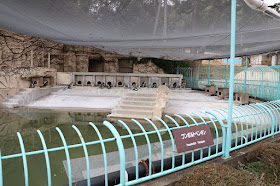Fukuoka
City is the 7th most populated city in Japan with more than 1.4
million people. The city-owned Fukuoka
Zoo & Botanical Garden is a large sprawling facility befitting of such a
large urban community. Opened at its
present location in 1953, Fukuoka Zoo has a zoological section and a botanical section.
In this blog, I will only discuss the
zoo section areas, and I will discuss them in the order that I viewed them.
Immediately
after entering through the main entrance, I went to what was described as the
South Garden. Here, the first area I encountered
was the:
Asia Tropical Forest
This
area was completed in 2013 and designed with a large and spacious elephant
enclosure. Sadly, at the time of my
visit, there were no elephants in residence.
Due to the decline of wild elephant populations, it has become very difficult
for Japanese zoos to replace their aging (and dying) elephants.
Spiral walkway leading from the elephant enclosure to the orangutan enclosure.
View looking down at the elephant enclosure that did not have elephants.
This was the only elephant I found during my visit.
Proceeding into the tropical forest, I saw:
Bornean Orangutan
Orangutan in a hammock.
Malayan Sun bear enclosure
This
exhibit included a 2nd floor viewpoint from where you could look
down into the enclosure.
The Malayan Sun bear enclosure also included a viewing spot that was located inside of the exhibit.
This is the entrance to the viewing spot.
Access to the viewing spot is through a small tunnel: fun for kids, but torture for anyone over 160 centimeters tall.
View of the Malayan Sun bear from the viewing spot.
View of Asian Tropical Forest complex
Leopards
Binturong
Leopard cat exhibit
Asian Short-clawed otter exhibit
Big Cats Area
Amur Tiger
The
Amur tiger enclosure was mainly a concrete slope with a small pool near the
bottom. There was also a perch for the
tiger to sit upon.
Reptile House
Phillipine Sailfin Lizard
Indian Star Tortoise
Japanese Deer, Raptors,
Birds
Two bucks were jousting.
Others
were just watching.
Just
across the way from the reptiles and deer were a number of birds in fairly
small quarters.
Ural
Owl
Nihon Kounotori
Hippopotamus enclosure
Children’s Zoo
This
area featured domesticated animals, including some that could be petted and/or
fed.
Ducks
Guinea
pig
Goats
On
the slopes below the children’s zoo were the Red Kangaroos.
Moving
from the South Garden back towards the main entrance, I next came upon the:
Red Pandas
Next
I moved onto the North Garden part of the zoo which was located on slopes
higher than the South Garden area. Here
I saw:
Chimpanzees
View of inside of cage.
Chimpanzee sleeping in a hammock.
Shooting photos through cage bars is never satisfying.
Next
door to the chimpanzees were:
Black Bears
Waterbird cage
This
large, walk-in exhibit featured flamingos, wild ducks, etc.
Continuing
up the hill, one comes upon the exhibits of animals found in Japan.
Japanese macaques
Exhibits
of Japanese tanukis, foxes, and Japanese badgers.
Tanuki - not a good portrait through bars.
Red
Fox
Moving along, there was a section devoted to
ungulates.
Arabian
Oryx
Barbary
Sheep
Zebra
Other facilities
Just
inside of the main entrance, there was an exhibit hall and a resource room.
Food and Souvenirs
In the South Garden area there
was a shop that sold snacks and souvenirs.
In
the main entrance building, there was a nice restaurant and a café which also
sold souvenirs. The curry and rice lunch
at the restaurant was delicious.
Getting There
I
visited Fukuoka Zoo with a friend who did the driving, so I cannot accurately
describe the route using public transportation.
According to the zoo’s pamphlet, the closest bus stop to the main gate
is the “Doubutsuen-mae” stop using bus routes #56 and #58. The pamphlet also describes a 15-minute walk
to the front gate from the subway Sakurazaka station. Admission to the zoo was 600 yen for adults,
300 yen for high school students, and free for intermediate students and
younger children.
(Note:
All photos in this post were taken during a visit made on February 20, 2019. The comments in this post are based on
observations made at that time.
Conditions may have since changed.
Please check it out for yourself!)






























































































